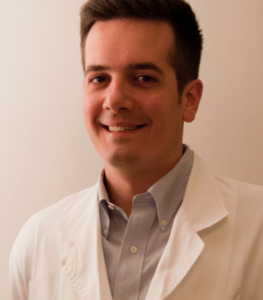What Sets Cancer Commons Apart?

Erika Vial Monteverdi, Executive Director of Cancer Commons
Cancer Commons is a patient-centric, nonprofit network of patients, physicians, and scientists that helps identify the best options for treating an individual’s cancer. Here, our Curious Dr. George asks executive director Erika Vial Monteverdi what sets Cancer Commons apart.
Q: As the Executive Director of Cancer Commons, how do you consider our approach to be uniquely different from that of many other organizations working to change the paradigm of cancer treatment?
A: Cancer Commons’ approach arises from the simple yet powerful fact that no two patients and their cancers are exactly alike. Supercomputers and “big data” present promising possibilities to advance cancer treatment. However, we believe that such efforts will fall short without also improving the use of existing information, coupled with expert doctors’ insights.
More to the point, every doctor would agree that, when it comes to making treatment decisions for very sick, one-of-a kind patients, the judgment of the best experts in the world coupled with existing data would be more convincing than existing data alone. In fact, we have seen that doctors will accept the judgments of experts when that judgment differs from their own, and are less likely to change their treatment plan based upon data alone.
Cancer Commons and our team of experts focus on advanced cancer patients for whom the treatment data are particularly thin, the treatment cost is particularly high, and the treatment success rate is particularly low. Our mission is to be the preeminent resource for advanced cancer patients by breaking down knowledge barriers to save lives.
In a currently fragmented U.S. healthcare system—with variation and disparity in cancer care, as well as a lack of information and resources for patients—Cancer Commons is especially important for those with hard-to-treat cancers who have exhausted standard-of-care options and often feel left alone to navigate next steps. These are the patients who are asking, what now?
We connect patients and their families to our Nurse Navigators and PhD Scientists, who combine a compassionate approach with deep scientific knowledge of cancer to help advanced cancer patients understand their disease and identify and access the best personalized tests, clinical trials, and treatments.
Our solution enables a patient-centric network of patients, nurse navigators, scientists, physicians and national experts to collectively reason and deliver a plan to patients. We elevate the patient to equal status of other industry stakeholders by cutting across organizational and information barriers and combining available knowledge with clinical experience to focus on what is best for each individual. We then apply those learnings to help the next similar patient.
Cancer Commons differentiates itself from all other cancer organizations through our transformative process, which aims to continuously learn from the experiences of all patients, on all treatments, all the time.
For anyone who is wondering, “what now?” for themselves or for a loved one with cancer, I encourage you to register now to get support from Cancer Commons.




 A Q&A with Razelle Kurzrock, MD, Director of the Center for Personalized Cancer Therapy and the Rare Tumor Clinic at U.C. San Diego, and Co-Founder and Board Member of CureMatch, Inc. Email: razelle@curematch.com
A Q&A with Razelle Kurzrock, MD, Director of the Center for Personalized Cancer Therapy and the Rare Tumor Clinic at U.C. San Diego, and Co-Founder and Board Member of CureMatch, Inc. Email: razelle@curematch.com A Q&A with David Spigel, MD, Chief Scientific Officer, Director of the Lung Cancer Research Program, and Principal Investigator at Sarah Cannon Research Institute. Email: dspigel@tnonc.com
A Q&A with David Spigel, MD, Chief Scientific Officer, Director of the Lung Cancer Research Program, and Principal Investigator at Sarah Cannon Research Institute. Email: dspigel@tnonc.com A Q&A with Alan Blum, MD, who founded the
A Q&A with Alan Blum, MD, who founded the  A Q&A with Kalpana Kannan, PhD, former Scientist at Cancer Commons
A Q&A with Kalpana Kannan, PhD, former Scientist at Cancer Commons A Q&A with Nicolò Matteo Luca Battisti, MD, Medical Oncologist at The Royal Marsden NHS Foundation Trust, London, United Kingdom, and Chair of the Young Interest Group of the International Society of Geriatric Oncology (SIOG); nicolo.battisti@gmail.com
A Q&A with Nicolò Matteo Luca Battisti, MD, Medical Oncologist at The Royal Marsden NHS Foundation Trust, London, United Kingdom, and Chair of the Young Interest Group of the International Society of Geriatric Oncology (SIOG); nicolo.battisti@gmail.com A Q&A with Burt Nabors, MD, Professor and Director of the Division of Neuro-oncology at the University of Alabama, Birmingham, and a member of the Cancer Commons Brain Tumor Advisory Board; bnabors@uabmc.edu
A Q&A with Burt Nabors, MD, Professor and Director of the Division of Neuro-oncology at the University of Alabama, Birmingham, and a member of the Cancer Commons Brain Tumor Advisory Board; bnabors@uabmc.edu A Q&A with Emma Shtivelman, PhD, Chief Scientist at Cancer Commons; emma@cancercommons.org
A Q&A with Emma Shtivelman, PhD, Chief Scientist at Cancer Commons; emma@cancercommons.org A Q&A with Anita Hjelmeland, PhD, Associate Professor of Cell, Developmental and Integrative Biology at the University of Alabama Birmingham School of Medicine
A Q&A with Anita Hjelmeland, PhD, Associate Professor of Cell, Developmental and Integrative Biology at the University of Alabama Birmingham School of Medicine